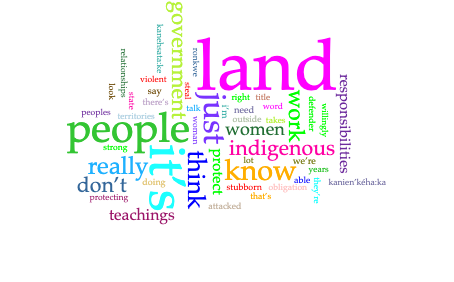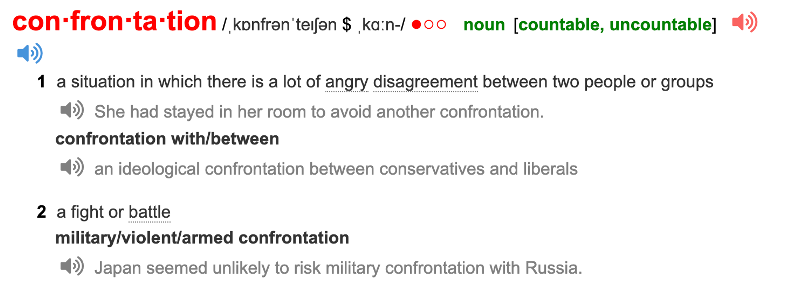Unit 11 Dignity: SDG16
Peace, Justice & Strong Institutions
![]()
Goal no. 16 of the 2030 Agenda for Sustainable Development aims to promote peaceful and inclusive societies for sustainable development, provide access to justice for all and build effective, accountable and inclusive institutions at all levels.
Click on the arrows to reveal more information about SDG16. You don’t need to remember everything you read – the main thing is to get an overview of this Goal.
Information and targets reproduced under the terms and conditions of United Nations websites. Copyright (2023).
A reminder that links in this e-book do not open in a new tab. If you click on any of the links to a webpage, click the back button in your browser to return here.
Key Vocabulary
Check that you know the meaning and the whole word family of these key words before you begin the Unit. (NOTE: there may be other versions of the word forms – these are the common forms in the context of SDG16). Also notice some common collocations in bold in the ‘Why this goal? and ‘Targets’ sections above. Add any new words, word families or collocations that you would like to remember to your vocabulary book.
Verb Noun Noun person Adjective
To keep the peace peace* peacekeeper/maker peaceful
To justify justice just
To sustain sustenance sustainable/sustained
To conflict with (smth/one) conflict conflicted
To be violent violence violent
To traffic trafficking trafficker trafficked
To participate participation participant participatory
To include inclusion inclusive
To have dignity/be dignified dignity dignified
*peacetime, peace offering
Introduction
In Units 9 and 10 you learned about the struggle many people experience to gain decent work and housing. In this Unit you’ll learn about the way people’s security and dignity are negatively affected by conflict, and by the unethical business practices of some institutions, and about the struggle of indigenous people to reclaim ancestral territories in Canada.
Data Visualisation – Positive peace
It is always useful to define the terms that we use. In this infographic you’ll read about a way of defining peace. Peace is commonly defined as an absence of violence, but here Nonviolent Peaceforce, a non-governmental and non-profit organisation whose aim is to protect civilians in violent conflicts through unarmed strategies, define peace as a set of positive conditions that need to prevail. Read this extract from their website:
‘We need to redefine peace. When we think about peace as the absence of violence we are merely thinking about negative peace. The pillars of peace [in the infographic below] sketch out positive peace and its 8 interconnected parts’.
Discuss
- Do you agree that it would be useful to reconsider the definition of peace? Is ‘an absence of violence’ too limited a way of defining peace? Do you know of any situation where there is no obvious violence, but it is nevertheless not ‘peaceful’?
- Nonviolent Peaceforce note that while conflict is inevitable violence is not, and say they don’t accept ‘that security or dignity are acceptable collateral damage (injury inflicted on something other than an intended target) when tensions build.’ To what extent do you agree with this statement?
- The security and dignity of people are often damaged as a consequence of conflict. Have you witnessed this in your own local context or elsewhere?
Read the infographic and complete the activity below.

Download the transcript here: Unit 11 infographic transcript
In your local context…
Which of the 8 pillars of peace from the infographic are well-established and which are precarious?
Pronunciation – Consonant clusters
In some words you can find two or more consonant letters or consonant sounds together. These are called consonant clusters. Being able to say groups of consonants is one of the core pronunciation features which aid mutual understanding when a non-native speaker of English talks to another non-native speaker.
Focus on 2 or 3 consonant sounds or letters occurring together
- At the beginning of a word, consonant clusters consist of two, or at most three, consonant sounds.
- Examples of two-consonant clusters at the beginning of a word: black, class, create, place, trade, slum.
- Three-consonant clusters at the beginning of a word always begin with the letter ‘s’, e.g. screen, street.
- Two- and three-consonant clusters can also appear between vowels, e.g. justice, sustainable, conflict, or at the end of a word, e.g. participant, understand.
Practice
If your first language does not allow so many consonants together without intervening vowel sounds, consonant clusters can be difficult to pronounce and this can lead to communication difficulties.
Listen and repeat these words, making sure not to introduce a vowel sound between the consonants in the cluster.
Play the audio here:
Two-consonant clusters:
- injury
- justice
- institutions
- mental
- dignity
- ask
Three-consonant clusters:
- strong
- split
- conflict
- demonstrate
Reading – Speak up and eliminate forced labour – business can be ethical and profitable
Before you read
- In the Listening in Unit 9 you heard about the treatment of foreign workers in Canada, and learned vocabulary to do with work status. Can you give a definition for the term ‘tied work permit’, associated with forced labour?
- The title of the text states that businesses can be both ethical and profitable. To what extent do you agree with this statement?
- In paragraph one there is a quote from Indra Nooyi, chairman and CEO of PepsiCo, when she was speaking at the World Economic Forum. She called on business leaders to change the dialogue from ‘what we do with the money we make’ to ‘how we make the money’. What point do you think she was trying to make?
- Companies like to present themselves to consumers as responsible, and many have Corporate Social Responsibility (CSR) policies, which include things such as making socially and environmentally conscious investments. Can you think of any other CSR policies that companies have?
Read for detail: Vocabulary – Forced labour
Scroll down to find the text and complete the reading task.
Speak up and eliminate forced labour – business can be ethical and profitable

When Indra Nooyi, chairman and CEO of PepsiCo, was speaking at the World Economic Forum in Davos in January this year, she called on business leaders and industry captains to change the dialogue from “what we do with the money we make” to “how we make the money”. The idea was that companies can run in an ethical way and be profitable at the same time. Even better, we think, if companies tightly focus their energies to concentrate on areas where genuine change can be made.
This may sound like old wine packaged in a new bottle – after all, many organisations have been practising corporate social responsibility (CSR) for a long time, with very little real impact. This is not that surprising. Such efforts are often a response to external pressure and are designed to enhance a company’s reputation, rather than re-orient a firm to make social benefits a part of business decisions. The CSR departments get a budget, but it is not being put to good enough use.
Businesses that truly care about wider society should be taking aim at particular examples of social injustice and using their corporate muscle to eradicate it. Sadly, there is a lot of social injustice to choose from. Here, we would like to pinpoint one of the biggest ones: human trafficking and forced labour. Most of us associate trafficking with human trafficking for sexual exploitation. Yet, according to the latest UN report, there is more forced labour than any other form of human exploitation in Africa, the Middle East, South and East Asia as well as the Pacific.
Out of sight
Human trafficking is an issue that we don’t see and therefore it is remote to many of us – so far removed from our daily lives that we are mostly unconcerned with it. Nevertheless, we are all implicated. We all have mobile phones that contain an ingredient called coltan. Coltan is only available from mines in Democratic Republic of the Congo rife with slavery and child labour. While we may be surprised to read this, there is a good chance that products that fill our shops in the developed world are the result of forced labour.
Human trafficking happens everywhere, even in supposedly well-developed countries. Take, for example, Singapore. The US State Department points out that many foreign workers in the country have assumed debt associated with their employment to the recruitment agencies, making them vulnerable to forced labour, including debt bondage. There were also reports of confiscation of passports, restrictions on their movement, illegal withholding of their pay, threats of forced repatriation without pay as well as physical abuse.
Certainly, NGOs have called for tougher penalties against errant companies and governments. However, legislation against human trafficking still varies widely from country to country. In addition, many politicians may prefer to look away from the issue, fearing that they would upset businesses. Indeed, even when the political will exists, NGOs and governments are often unable to turn it into action. Therefore, we would urge companies and consumers alike to take the initiative themselves.
Taking responsibility
The financial crisis has shown us that our brand of shareholder capitalism can be detrimental to our societies. Of course, the argument runs that businesses pay a lot of taxes, keep people employed and make new investments; companies are already making significant contributions to society. However, this view effectively assumes that anything that is outside the scope of the firm is not the firm’s responsibility. Companies cannot, and should not, be responsible for taking care of society as a whole, but they should do their utmost to eliminate and prevent social harms and problems linked to their activities. Sadly, while many firms have been addressing human trafficking, many more have not.
The Rana Plaza Tragedy in Savar, Bangladesh in May 2013 provided a tragic illustration of the problem. The products for many world-famous brands were manufactured under the roof of the collapsed factory. One would imagine that that these companies would have sufficient processes in place to preclude labour exploitation. Yet, in addition to being paid only €38 a month, labourers had to work in dire conditions. Poverty drove them into situations where they couldn’t say “no” for fear of losing their jobs. Young people and children effectively work in forced labour conditions – these young “helpers” earned 12 cents an hour, while “junior operators” took home 22 cents an hour or $10.56 a week and senior sewers received 24 cents an hour or $12.48 a week.
Perhaps more incredibly, it was reported that at least one famous brand was unsure whether or not its products were made there. Companies may pride themselves on their ability to manage complex supply chains and outsourcing. However, very often, they lack the necessary processes and routines to check whether their contractors are exploiting labour.
Consumer power
Responsible companies would be asking what steps they are taking to ensure that their entire supply chain is free from unfair and unethical labour practises, especially those outsourced abroad. But it is an open question of how far brands go to monitor suppliers and whether they take full responsibility for the conditions in which those employed by third-party contractors are working? This needs to be discussed publicly. Otherwise, companies that believe they are working for the good of society may have inadvertently supported some forms of exploitation in distant parts of their value chains.
And of course, we, as consumers, should start to question our ceaseless demand for dirt cheap products. We are feeding companies’ drive to source as cheaply as possible. The extra pound, dollar or euro in our pocket could easily come at the expense of someone’s suffering, or as the disaster in Savar shows, someone’s life.
Human trafficking of any sort, and not just forced labour, is modern-day slavery. We should not allow it to perpetuate any further. A good first step is to not shut up about it. Speak up. Because in the end, we, companies and consumers alike, are responsible for everything we do – and everything we don’t.
NB This version of the article, with permission from the author, does not include the hyperlinks to supporting articles found in the original. Click the title for the full version of the text, published under a CC BY ND licence in The Conversation, which should be used for reference and sharing.
After you read – oral summary
Without looking at the text again work with a partner and take it in turns to make an oral summary of some of the main points, incorporating at least four of these terms:
unethical labour practices human exploitation child labour
human trafficking debt bondage social injustice
forced labour modern slavery
In your local context…
In Unit 1 you considered consumer patterns. Are you part of a society that drives the endless demand for more stuff, or part of one that suffers from it? The text illustrates the interaction between SDG12 Responsible Consumption and Production and SDG16 Peace, Justice and Strong Institutions. Re-read this extract and relate it to your own experience.
‘And of course, we, as consumers, should start to question our ceaseless demand for dirt cheap products. We are feeding companies’ drive to source as cheaply as possible. The extra pound, dollar or euro in our pocket could easily come at the expense of someone’s suffering, or as the disaster in Savar shows, someone’s life’.
Function – Demonstrating logic
Focus on sentence connectors to demonstrate logic
- In Unit 2 you learned connectors for comparing and contrasting, and in Unit 4 you learned ways to express caution. How many of the connectors can you remember? Do this matching task to check your knowledge. Click the ‘start’ button, then drag and drop each of the phrases in the boxes at the top into the appropriate box underneath.
2. In paragraph 6 in the text (‘Speak up and eliminate forced labour’) each sentence begins with a connector. Read the paragraph (copied below) noticing the connectors in bold and decide what function each one performs. Choose the correct one from the list:
emphasis contrasting information consequence additional information
‘Certainly, NGOs have called for tougher penalties against errant companies and governments. However, legislation against human trafficking still varies widely from country to country. In addition, many politicians may prefer to look away from the issue, fearing that they would upset businesses. Indeed, even when the political will exists, NGOs and governments are often unable to turn it into action. Therefore, we would urge companies and consumers alike to take the initiative themselves.’
Practice
Listening – Indigenous land defenders (7 mins)
![]()
Credit: The Conversation, Don’t Call Me Resilient, 6. Ibrahim Daair, Culture + Society Editor and Vinita Srivastava, Host + Producer, Don’t Call Me Resilient | Senior Editor, Culture + Society. Licence: CC BY ND

You’ll hear Ellen Gabriel, who has been resisting land encroachment for 31 years and was at the centre of the 1990 Kanehsatake resistance, a 78-day stand-off to protect ancestral Kanien’kéha:ka land in Québec, Canada, and Anne Spice, who is Tlingit from Kwanlin Dun First Nation, and was recently on the front lines in the defence of Wet’suwet’en Land. After she was arrested in 2020 a viral video showed the Royal Canadian Mounted Police pointing a gun at the land defenders. In the video Spice can be heard shouting ‘we are unarmed, and we are peaceful’.
Before you listen
- What do you think?
- Gabriel and Spice are at the forefront of the battle for Indigenous land rights. Their fight is fundamentally about survival and the right to live openly on what is stolen land. What do you know about Canadian Indigenous Peoples and their struggle for land rights?
- Gabriel explains that ‘the women are title holders to the land and the protectors of the land. And the men’s obligation is to protect the women who are protecting the land’. What do you think the difference is between viewing yourself as a ‘title holder’ to the land, and being a landowner?
- Spice says ‘I think the land defender is not a title that you claim for yourself. It’s an action. And it’s about the practice of actually being on the land and reclaiming ancestral territories and territories that are under attack’. What do you think she means?
- Look at the word cloud created from the transcript. The most frequently used words (the biggest ones in the cloud) are: land (24), people (10), think (6), know (6), work (5), indigenous (5), government (5), women (4), teachings (4), responsibilities (4), protect (4). With the title in mind (‘Indigenous land defenders’) create a sentence that uses as many of these words as possible and predicts the main point of the listening.

Listen for main idea
Play the audio here
(Or access The Conversation podcast and listen from 2.25 mins to 9.32mins).
Listen once all the way through and make very brief notes about the struggle the women face (don’t try and write down exactly what you hear). When you have finished work in pairs and summarise what you think the main points that Gabriel and Spice are making. Give your partner feedback on their summary, adding any points they may have missed, or discussing any that you understood differently.
Listen for detail: Vocabulary – Confrontation

Listen again and as you listen complete the summary by writing a word/phrase from the list into the gaps. NOTE that the summary is a shortened version of the audio and the activity is a test of listening for small detail. You may need to pause the audio when you hear a relevant part, therefore.
Download the transcript here: Unit 11 Listening transcript
Writing
In this Unit you’ve learned how peace can be defined and heard from indigenous women who are defending ancestral lands in Canada. Myrna lives in a conflict hotspot in the Philippines and her story illustrates the work of Philippine women to promote peace.
Read Myrna’s story and write a response to it that incorporates what you know about definitions of peace and SDG16 Peace, Justice and Strong Institutions. Write about:
- Myrna’s experience of conflict.
- How she helps protect women and children from male violence.
- Her work to promote peace in the area and your view about how useful local, community-based projects are.
- Any other topic relevant to conflict and peace processes and SDG16.
Women as Bringers of Peace
Lagunde, Pikit, North Cotabato, is one of the identified conflict hotspots for more than 40 years located in the Philippines. A mother of four, Mryna has witnessed with her own eyes how communities and families shatter in conflict and violence. “I can still remember that day. We were all in a hurry to flee our homes, and I was still pregnant with my first child,” shares Mryna.
Mryna is a devoted member of the Social Welfare Committee of Barangay Lagunde. Once a week, she would gather with all Muslim mothers to transfer her knowledge to make sure that their families are cared for. More importantly, she is helping with the advocation for the prevention of Violence Against Women and Children.
Currently, she is also taking part in the “Promoting Conflict Prevention, Social Cohesion and Community Resilience in BARMM” [Bangsamoro Autonomous Region in Muslim Mindanao] in the Time of COVID-19 with 252 other community leaders. In this programme, community leaders work with other leaders from local government and community-based organizations to promote peace as the pandemic coincides with the political transition period, following the formal establishment of the BARMM in 2019 through the ratification of the Bangsamoro Organic Law.
Department of Economic & Social Affairs Statistics Division (2022) ‘Bringing Data to Life: SDG impact stories from across the globe.’ Available at: https://unstats.un.org/sdgs/report/2022/SDG2022_Flipbook_final.pdf
Speaking
Read the summary and discuss the question that follows:
SDG16 Summary
Strengthened institutions, rule of law and enforcement contribute to supporting the implementation of multi-lateral environmental agreements and progress towards internationally agreed global environmental goals.
A better understanding of the links between environment and human security is vital for effective conflict prevention, post-conflict reconstruction and promotion of peaceful and inclusive societies. In the past 60 years, 40 per cent of conflicts have been tied to natural resources and these are twice as likely to relapse into conflict within the first five years.
Reproduced with kind permission of the UN Environment Programme. Copyright (2023). All rights reserved.
Climate change is not a direct source of conflict, but is seen as a threat multiplier that exacerbates resource scarcity and existing vulnerabilities (i.e. the effects of climate change interact with other pre-existing threats and drivers of instability to contribute to security risks). In recent times violent conflicts have been tied to the exploitation of natural resources, whether high-value resources like timber, diamonds, gold, minerals and oil, or scarce ones like fertile land and water.
- In your local context what evidence is there of climate change acting as a threat multiplier?
- In your local context what evidence is there of conflict arising from competition for natural resources?
A reminder that if you have access to the internet and are studying by yourself without other people to practice your spoken English with, you can use artificial intelligence (AI) to gain fluency practice. See here for instructions and prompts.
Here are some prompts related to this Unit:
- ‘Let’s have a dialogue about whether businesses can be both ethical and profitable. Give me some examples of businesses that seem to behave ethically but are also highly profitable and we’ll have a conversation about them.’
- ‘Let’s have a conversation about societies that drive the endless demand for more consumer products. Tell me about countries where consumer demand for goods is high, and compare them to countries where workers must tolerate low pay and poor working conditions to try and satisfy this demand. Give me lots of opportunities to respond and ask questions.’
Looking Ahead to Unit 12
In Unit 12 you’ll learn about the struggle to safely access clean running water that people, invariably women, experience in many parts of the world.
- Many women walk miles each day to carry water home, and this gender-specific role has a severe impact on every aspect of their lives. Can you predict what some of these impacts might be?
- What kind of business practices do you think might arise when an essential resource such as water is scarce?
- Have areas of your country ever suffered from drought or water scarcity?
Use the menu bar on the left hand side of the screen to access Unit 12

